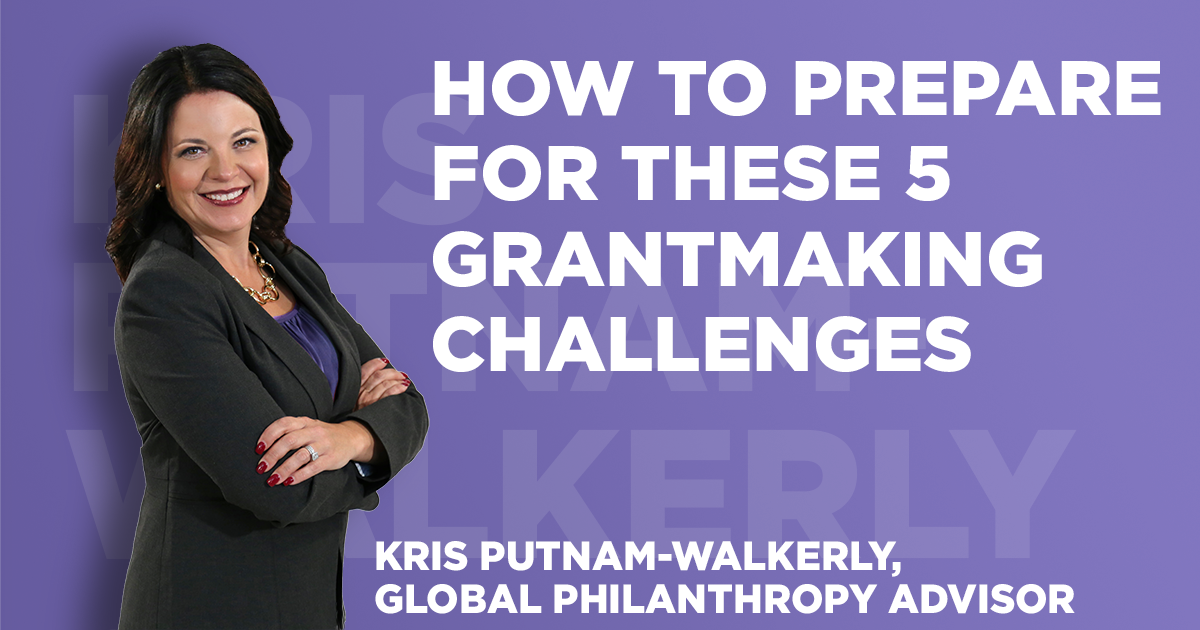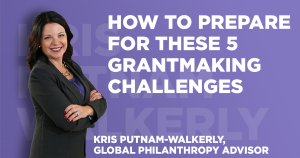Do more than ready yourself for the unexpected.
We have been told for most of our lives to prepare for the unexpected—save for a rainy day, have a Plan B and apply to some “safety schools” in case you don’t get accepted by your top-choice university. While being prepared for the unexpected is smart, it’s not as important as being prepared for the expected.
As a philanthropist, your ultimate goal is to make the world a better place. To put ideas into action and create change where it is needed. One way to achieve this impact quickly and effectively is to be prepared for the expected. Problems will arise—that’s a guarantee—so you might as well be ready to deal with them.
Here are five common challenges you can expect as a donor and what you can do to prepare for them:
1. There will be a lack of patience and a lot of pressure during planning. You’re designing a new grant program. Everyone is on board, your team is enthusiastic and planning efforts are underway. But the board will want to see grantmaking activity before you’ve finalized your goals. It doesn’t matter that they already agreed on a timeline for you to develop your strategy and to assemble the right partners to implement it—they will put on pressure for proof of progress. Prepare early by identifying some low-hanging fruit. Award a few grants to pilot some of your ideas. You can learn from the results while also meeting your board’s need to “do something.”
2. You will need data. You’re starting a five-year funding initiative, and you know in your bones that when it’s over, the project will need another five years to solidify and continue the investment. But when that time rolls around, you’ll need to prove it. Prepare now by putting an evaluation plan into place. Collect data every year: You’ll want to watch for alignment across your grantees’ objectives, understand which interventions had the greatest impact and know what course corrections were the most effective. What you won’t want is to realize at the project’s conclusion that you invested a significant amount of time, energy, and dollars every year—but you don’t know where that all went. Be sure to plan your evaluation strategy in advance and collect data as you go.
3. There will be risk. Every project worth doing will involve risk. There’s always the risk of failure, risk to your foundation’s reputation, risk that resources will be spent on a project that doesn’t meet its goals, risk of straining the relationship with the community. It’s better to accept the reality of risk now than be surprised by it later. One excellent way to handle risk efficiently is to create a “Risk List.” Gather everyone involved (your team, partners, stakeholders) and brainstorm all the potential risks associated with what you are about to do. Write them down. Assess the risks (cost, benefit, strategic fit, etc.) and discuss ways to mitigate them. Incorporate your ideas into your work plan. Don’t lose that list! At your next meeting, and at each consecutive meeting, pull out the Risk List, cross off anything you’ve handled and add any new ones that you can now envision. You’ll take the fear out of risk and increase your likelihood of success.
4. You must be clear. No one will understand or be able to support your goals if you don’t make them explicit from the start. When you issue a request for proposals or write up your funding guidelines, make sure you are crystal clear about what you’re trying to accomplish. Make sure to clarify with all parties what your goals and objectives are, the type of organizations you want to fund, your expectations and assumptions, the range of grant amounts, how funds can be used, what grantees can expect in terms of reporting and participation, etc. Do your research! Ask your colleagues or nonprofit leaders to review your guidelines before you publicize them to make sure your meaning is understood. The less clear your requests are, the more likely you will receive poorly written, inappropriate proposals from organizations you will never fund. This wastes everyone’s time and slows down your ability to reach your philanthropic goals.
5. You must provide constant communication. Not only must you state your goals clearly—you must state them early and often. One of the best pieces of advice I ever received was that “communication begins the moment you open your mouth and start talking about your new idea.” It’s true: The second you speak your idea out loud, you need to develop a communications plan. Even though your new initiative is just a tiny sprout of an idea, as it takes shape, your communications plan should ensure that all key stakeholders are informed, that your partners are communicating and coordinating with each other and that external audiences—the media, businesses, other foundations, etc.— are aware and supportive of your project. If your team members and supporters don’t know what’s going on, they have a much poorer chance of helping you. They won’t be able to work together effectively, and your initiative will start to unravel. The earlier you create a communications plan the better, but it’s never too late to start one—even if your project is already in motion.
Being unprepared can set you back in your confidence as a grantmaker. It wastes time and it dampens your impact. The good news is that it’s never too late to start preparing for the expected. You have what it takes to be an extraordinary grantmaker. The first step is being prepared. Take 15 to 30 minutes to discuss this list with your colleagues. Figure out what you may not be prepared for, and incorporate a plan to address it going forward. You will be well on your way to more dramatic impact.
Behind every successful person is an expert coach advising them along the way – grantmakers are no exception. If you’re not sure where to begin addressing these challenges, I can help! Schedule a call with me or shoot me an email to learn more about my philanthropic advisory services. We’ll get you overcoming these challenges and achieving your philanthropic goals so you can focus on making the world a better place and having a lasting impact on your community.
This article was originally written for and published by Forbes.com.
© 2019 Kris Putnam-Walkerly. All rights reserved. Permission granted to excerpt or reprint with attribution.
About Kris Putnam-Walkerly
I’m a global philanthropy expert, advisor and award-winning author. I help ultra-high net worth donors, celebrities, foundations and Fortune 500 companies dramatically increase the clarity, speed, impact and joy of their giving. I’m the author of Confident Giving: Sage Advice for Funders, was named one of “America’s Top 25 Philanthropy Speakers”(along with U2’s Bono!), I write about philanthropy for Forbes.com, Alliance Magazine, De Dikke Blauwe and am frequently quoted in leading publications such as Bloomberg, NPRand WSJ.
Whether you are just getting started in philanthropy, want to refresh your giving strategy, or need to catapult yourself to your desired future, I can help. Let’s talk! Call me at +1-800-598-2102 x1, email me at kris@putnam-consulting.com or schedule a call.
__________________________________________________________________________
“Kris has a direct, matter-of-fact style and unquestionable logic when it comes to corporate giving in ways that are efficient, effective and ultimately beneficial for communities and companies alike. She also knows how to explain her ideas clearly and simply in ways that shine through the fog of ‘corporate-speak’.”
Alicia Procello Maddox, President, Avery Dennison Foundation
__________________________________________________________________________
Want to learn more? Visit my website to learn how I help funders, access free resources, and read client testimonials.








